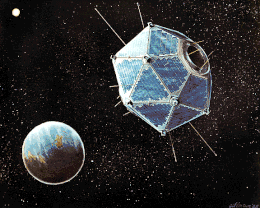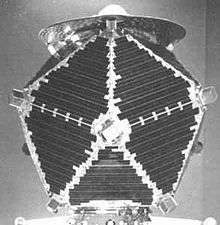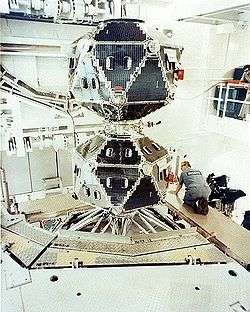Project Vela
Project Vela was a project undertaken by the United States Department of Defense[1] to develop and implement methods to monitor compliance with the 1963 Partial Test Ban Treaty. This treaty banned the testing of nuclear weapons in the atmosphere, in outer space, and underwater, effectively meaning nuclear tests were only to be permitted underground.

Early history
In August 1959, several groups focused on detecting underground nuclear tests were established within the US Department of Defense; on September 2, 1959, the Secretary of Defense assigned the research responsibilities to the Advanced Research Projects Agency (ARPA). This initial assignment involved seven tasks:[2] creating a worldwide network of standardized seismological stations; conduct research relating to underground test detection, and on seismic detection stations; conduct nuclear and chemical underground tests to expand knowledge of seismic signatures; and three tasks of a more administrative nature. From the beginning, however, and through 1960, ARPA pressed to add research for testing surface-based, atmospheric, and outer-space detonations, and advocated satellites as a potential platform for such detections.[3]
The Vela Project started as a small budget research program within the DARPA[1] Projects Agencies until 1961 when it was granted greater funding and resources through the authority of the Deputy Assistant Secretary of the Army.[1] This was likely prompted by increased caution over Domestic Nuclear Affairs resulting from the 1961 Goldsboro B-52 crash as well as in anticipation of the 1963 PTB Treaty.
The initial project was limited to the development of the Vela Satellites, but was later expanded and reorganized into three distinct levels of monitoring:
- Vela Uniform, which was the portion of the project dedicated towards monitoring seismic signals, in order to detect underground and underwater nuclear testing
- Vela Hotel, which was a continuation of the satellite program to detect nuclear testing solely beyond the atmosphere at an extended range
- Vela Sierra, which was a set of advanced satellites that were designed to detect testing both in the close reaches of outer space and within the atmosphere of the planet itself.
The project's space and atmospheric divisions operated until the emplacement of satellites in the Defense Support Program (DSP), and were later integrated into the Global Positioning System set of satellites. Currently, all satellites under Project Vela are under the management of IONDS. The seismic division of Project Vela remains in activity today.
Vela Hotel and the Initial Vela Project

There is very little documentation which directly addresses the topic of the initial Vela Project due to its low funding, staffing, resources and status of priority. However, it is known that the majority of the work done on the initial Vela Project was implemented into Vela Hotel, which monitored outer space for nuclear tests. The Vela Hotel satellite program was primarily developed at Los Alamos Scientific Laboratory, under the supervision of the United States Air Force. A system of X-ray, Neutron, and Gamma-Ray detection monitored for nuclear testing beyond the atmosphere.
The satellites' instrumentation count[4] included 12 X-ray detectors, 18 internal Neutron and Gamma-ray detectors, data transmission equipment to send the information back to Earth, and a set of Solar Panels which generated 90 watts to power the instrumentation on each satellite. Six of the Vela Hotel series satellites were manufactured, each with a design life of six months, and they were launched a week after the PTB Treaty on October 17, 1963. After deployment these satellites remained operational and online for 5 years before being shut down.
The Vela Hotel series of satellites never detected any weapons being tested in outer space, but thy did provide the scientific community with valuable data regarding the mechanics of the solar system. Importantly, this series of satellites was responsible for discovering Gamma-Ray Bursts,[5] markers of collapsing stars and black holes which are now recognized as the most violent events in the universe. The discovery of Gamma-Ray Bursts enabled scientists with unprecedented ability to map the universe as they augmented existing methods of measuring light to identify deep space objects.
Vela Sierra and the Advanced Vela Series

After the completion of development on the first set of Vela Satellites in the Hotel series, DARPA began work on the next phase of the Vela satellite program, namely, on Vela Sierra, which was intended to monitor the atmosphere for covert nuclear tests. Following the deployment of the Hotel series, Los Alamos resumed development on the satellites, this time working towards the Advanced Vela series. These new satellites were created with the intention that they would replace the Hotel Series, as well as function as the satellites that would complete the objectives of the Vela Sierra subset.
The new set of Advanced Vela satellites were equipped with the same detection equipment as the Hotel series,[4] those being the 12 X-ray detectors and 18 internal Neutron and Gamma-Ray detectors, but were also equipped with a new set of instruments. The Advanced Vela series came equipped with two non-imaging photodiode sensors called bhangmeters. These measured light levels over sub-millisecond intervals, and could detect a nuclear explosion to within 3,000 miles. This addition was necessary due to the singular effects that atmospheric nuclear explosions produce, called either the "Double Flash" or the "Double-Humped Curve," which is a pair of flashes of light caused by an explosion, one lasting a millisecond which is quite intense and bright, the other far more prolonged and less intense. This "Double Flash" is what distinguishes atmospheric nuclear explosions from other kinds of explosions in the atmosphere, along with radiation, since the only feasible event that could theoretically produce a double event like an atmospheric nuclear explosion would be something incredibly rare like a meteoroid generated lightning superbolt.[6][7] However, radiation in the atmosphere is far less easy to calculate, as the Van Allen radiation belts can mask radioactive wavelengths and signatures. The Advanced Vela satellites were additionally fitted with larger solar panels, since the new design required 120 watts as opposed to the Hotel series' 90 watts, as well as electromagnetic sensors for detecting an electromagnetic pulse from an in-atmosphere detonation. The new set of satellites had a design life of 18 months, but instead lasted on average 7 years, with the longest lasting of the set (Vehicle 9) being shut down in 1984, lasting around 15 years before being shut down.
Vela Sierra's most famous actual event was the "Double Flash" detected on September 22, 1979 by Vela satellite 6911 near the Prince Edward Islands.[8] However, due to the lack of any corroborating evidence that a bomb ever went off in the area other than the readings the satellite provided, it is widely regarded as either a malfunction or a magnetospheric event[6][7][8] affecting the instruments aboard the satellite. At the time of the event, President Jimmy Carter deemed the event evidence of a joint Israeli-South African nuclear test,[9] though since then no evidence has been uncovered to corroborate whether that is true or untrue.
Vela Uniform
Vela Uniform was the second half of Project Vela that began its development soon after the PTB Treaty was put into effect. Vela Uniform was created with the intention of monitoring seismic activity in order to determine the magnitude and location of any covert nuclear weapons tests beneath the surface of the earth. Underground tests have been illegal under international law since the widespread ratification of the Comprehensive Nuclear-Test-Ban Treaty (CTBT). Vela Uniform can also detect underwater tests conducted at any point on the Earth's surface. The methods DARPA used to create a system with which they could determine the difference between a regular seismic event and an underground covert nuclear test involved the rigorous measurement of seven nuclear tests in the continental United States, as well as numerous smaller experiments using conventional high explosives rather than nuclear explosions.[10][11]
| Test name | Date | Location | Yield | Test series |
|---|---|---|---|---|
| Shoal | 1963-10-26 | Sand Springs Range 39.20012°N 118.38124°W | 12 kt | Niblick |
| Salmon | 1964-10-22 | Salmon Site 31.14229°N 89.57001°W | 5.3 kt | Whetstone |
| Long Shot | 1965-10-29 | Amchitka Island, Alaska 51.43709°N 179.18032°E | 80 kt | Flintlock |
| Sterling | 1966-12-03 | Salmon Site 31.14229°N 89.57001°W | 380 t | Latchkey |
| Scroll | 1968-04-23 | Nevada Test Site 37.33767°N 116.37647°W | < 20 kt | Crosstie |
| Diamond Dust | 1970-05-12 | Nevada Test Site 37.0104°N 116.20277°W | < 20 kt | Mandrel |
| Diamond Mine | 1971-07-01 | Nevada Test Site 37.01148°N 116.20427°W | < 20 kt | Grommet |
Over time, Vela Uniform's methods and techniques for measuring seismic activity to determine the existence and location of covert underground nuclear tests have improved, and stations for seismographical monitoring exist all around the world. This has had the effect of giving more nations the ability to better understand their own country's seismic activities, and has given more and more countries access to aid in situations of earthquakes, tsunamis, and other such events, as well as ensuring the detection of any future covert underground nuclear tests.
References
- U.S. Department of Defense. Advanced Research Projects Agency. (1961, July 20). ADDENDUM to: Proceedings of Symposium: Project Vela (1st ed.) (263145). Washington, DC: U.S. Government Printing Office. Retrieved May 24, 2017 from the World Wide Web: http://www.dtic.mil/dtic/tr/fulltext/u2/263145.pdf.
- The Advanced Research Projects Agency, 1958-1974, Barber Associates, December 1975, pages IV-28 to IV-29.
- Barber Associates, loc. cit.
- Wade, M. (Ed.). (2016, July 11). Vela. Retrieved May 24, 2017, from http://www.astronautix.com/v/vela.html
- Klebesadel R.W.; Strong I.B. & Olson R.A. (June 1, 1973). "Observations of Gamma-Ray Bursts of Cosmic Origin" (PDF). Astrophysical Journal Letters . 182: L82-85. Bibcode: 1973ApJ...182L..85K. doi:10.1086/181225. Retrieved May 24, 2017.
- Dunning, Brian (26 January 2010). "Skeptoid #190: The Bell Island Boom". Skeptoid. Retrieved 22 June 2017. N.B. quote (emphasis added): "They also picked up large lightning flashes, and it was in part from the Vela satellites that we learned about lightning superbolts. About five of every ten million bolts of lightning is classified as a superbolt, which is just what it sounds like: An unusually large bolt of lightning, lasting an unusually long time: About a thousandth of a second. Superbolts are almost always in the upper atmosphere, and usually over the oceans."
- Lightning Superbolts Detected By Satellites, Science Frontiers, September 1977, No. 1, which in turn cites: Turman, B. N.; "Detection of Lightning Superbolts". Journal of Geophysical Research, 82(18):2566–2568, 1977. doi:10.1029/JC082i018p02566. Retrieved from Science-Frontiers.com website May 24, 2017.
- Conner JP, Evans WD, Belian RD (Sep 1969). "The Recent Appearance of a New X-Ray Source in the Southern Sky". Ap J. 157: L157–9. Bibcode: 1969ApJ...157L.157C. doi:10.1086/180409.
- New York Times. South Africa Stops Short Of Denying Nuclear Test, The Ledger, Lakeland, Florida, originally from The New York Times, 27 October 1979
- "United States Nuclear Tests, July 1945 to 31 December 1992" (NWD 94-1), Robert Standish Norris and Thomas B. Cochran, Nuclear Weapons Databook, Working Papers, Natural Resources Defense Council, 1350 New York Avenue, N.W., Suite 300, Washington, DC 20005, 202-783-7800, 1 February 1994.
- "Nuclear Explosions and Earthquakes: The Parted Veil," Bruce A. Bolt, W. H. Freeman and Company, San Francisco, 1976, ISBN 0-7167-0276-2